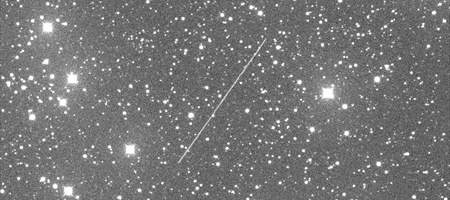Over the past couple of days, two asteroids ‘2012 XE54’ and ‘4179 Toutatis’ passed close to Earth.

4179 Toutatis, a lumpy shaped asteroid which is roughly 3 miles (5 km) long, is classified as a potentially hazardous object (PHO) by astronomers and has passed closed to Earth several times before, in 1992, 1996, 2000, 2004 and 2008. PHOs are asteroids or comets with orbits that come within less than 19.5 lunar distances, 4.6 million miles from Earth’s orbit (one lunar distance is the distance between the moon and earth).
Toutatis flew safely past Earth this time, passing us at a relatively safe distance of 4.3 million miles and was visible from the Canary Islands at 8pm last night. It will also be visible from most medium to large backyard telescopes over the next few days, as it passes by the constellations of Cetus and Pisces. And it seems we may be safe from Toutatis for the time being at least; astronomers predict that we are unlikely to collide with the asteroid in the next six centuries.
Astronomers also identified another close fly by from an asteroid known as ‘2012 XE54’ on December 11. At an estimated 72-160 feet, XE54 is a much smaller specimen than Toutatis, but passed much closer at a distance of just 140,000 miles from Earth. The asteroid came so close that it crossed Earth’s shadow causing a partial eclipse of the asteroid making it disappear briefly in the night sky before reappearing.
Pasquale Tricarico, a research scientist at the Planetary Science Institute described the phenomenon on his blog saying:
“Asteroids eclipsing during an Earth flyby are relatively rare, with the first known case of asteroid 2008 TC3 which was totally eclipsed just one hour before entering Earth’s atmosphere over Sudan in 2008, and asteroid 2012 KT42 experiencing both an eclipse and a transit during the same Earth flyby in 2012.”






